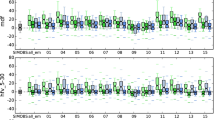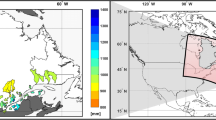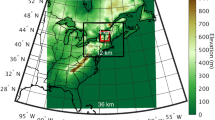Abstract
Increasingly, data from Regional Climate Models (RCMs) are used to drive hydrological models, to investigate the potential water-related impacts of climate change, particularly for flood and droughts. Generally, some form of further downscaling of RCM data has been required, but recently the first decadal-length runs of very high resolution RCMs (with convection-permitting scales) have been performed. Here, a set of such runs for southern Britain has been used to drive a gridded hydrological model. Results using a 1.5 km RCM nested in a 12 km RCM driven by European-reanalysis boundary conditions show that the 1.5 km RCM generally performs worse than the 12 km RCM for simulating river flows in 32 example catchments. The clear spatial patterns of bias are consistent with bias patterns shown in the RCM precipitation data. Results using 1.5 and 12 km RCM runs for the current climate and a potential future climate (driven by GCM boundary conditions) show clear differences in projected changes in flood peaks. The 1.5 km RCM tends towards larger increases than the 12 km RCM, particularly in spring and winter. If robust, this could have important consequences for adaptation planning under climate change, but further research is required, particularly given the greater biases in the baseline flow simulations driven by 1.5 km RCM data, and the use of only a single short future climate projection.






Similar content being viewed by others
References
Addor N, Seibert J (2014) Bias correction for hydrological impact studies – beyond the daily perspective. Hydrol Process 28:4823–4828
Ban N, Schmidli J, Schär C (2014) Evaluation of the convection-resolving regional climate modeling approach in decade-long simulations. J Geophys Res Atmos 119:7889–7907
Bayliss AC, Jones RC (1993) Peaks-over-threshold flood database: Summary statistics and seasonality, IH Report No. 121. Institute of Hydrology, Wallingford
Bell VA, Kay AL, Jones RG, Moore RJ (2007) Development of a high resolution grid-based river flow model for use with regional climate model output. Hydrol Earth Syst Sci 11:532–549
Bell VA, Kay AL, Jones RG, Moore RJ, Reynard NS (2009) Use of soil data in a grid-based hydrological model to estimate spatial variation in changing flood risk across the UK. J Hydrol 377:335–350
Bell VA, Kay AL, Cole SJ et al (2012) How might climate change affect river flows across the Thames Basin? An area-wide analysis using the UKCP09 regional climate model ensemble. J Hydrol 442–443:89–104
Chan SC, Kendon EJ, Fowler HJ et al (2013) Does increasing the spatial resolution of a regional climate model improve the simulated daily precipitation? Clim Dyn 41:1475–1495
Chan SC, Kendon EJ, Fowler HJ et al (2014) Projected increases in summer and winter UK sub-daily precipitation extremes from high-resolution regional climate models. Environ Res Lett 9:084019
Chiverton A, Hannaford J, Holman I et al (2015) Which catchment characteristics control the temporal dependence structure of daily river flows? Hydrol Process 29:1353–1369
Cole SJ, Moore RJ, Aldridge T et al (2013) Real-time hazard impact modelling of surface water flooding: some UK developments. In: Butler D et al (eds) Proceedings of the International Conference on Flood Resilience: Experiences in Asia and Europe (ICFR 2013). University of Exeter
Crooks SM, Naden PS (2007) CLASSIC: a semi-distributed modelling system. Hydrol Earth Syst Sci 11:516–531
Crooks SM, Kay AL, Davies HN, Bell VA (2014) From catchment to national scale rainfall-runoff modelling: demonstration of a hydrological modelling framework. Hydrology 1:63–88
Dankers R, Feyen L (2008) Climate change impact on flood hazard in Europe: an assessment based on high-resolution climate simulations. J Geophys Sci 113:D19105
Durman CF, Gregory JM, Hassell DC et al (2001) A comparison of extreme European daily precipitation simulated by a global and a regional climate model for present and future climates. Q J R Meteorol Soc 127:1005–1015
Ehret U, Zehe E, Wulfmeyer V et al (2012) Should we apply bias correction to global and regional climate model data? Hydrol Earth Syst Sci 16:3391–3404
Fischer EM, Knutti R (2013) Robust projections of combined humidity and temperature extremes. Nat Clim Chang 3:126–130
Graham LP, Hageman S, Jaun S, Beniston M (2007) On interpreting hydrological change from regional climate models. Clim Chang 81:97–122
Hewitson B, Janetos AC, Carter TR et al (2014) Regional context. In: Barros VR et al (eds) Climate Change 2014: Impacts, Adaptation, and Vulnerability. Part B: Regional Aspects. Contribution of Working Group II to the Fifth Assessment Report of the Intergovernmental Panel on Climate Change. Cambridge University Press, Cambridge, pp 1133–1197
Hough M, Palmer S, Weir A et al (1996) The Meteorological Office Rainfall and Evaporation Calculation System: MORECS version 2.0 (1995). An update to Hydrological Memorandum 45. The Met. Office, Bracknell
Huang S, Krysanova V, Hatterman FF (2014) Does bias correction increase reliability of flood projections under climate change? A case study of large rivers in Germany. Int J Climatol 34:3780–3800
Kay AL, Crooks SM (2014) An investigation of the effect of transient climate change on snowmelt, flood frequency and timing in northern Britain. Int J Climatol 34:3368–3381
Kay AL, Jones DA (2012a) Transient changes in flood frequency and timing in Britain under potential projections of climate change. Int J Climatol 32:489–502
Kay AL, Jones RG (2012b) Comparison of the use of alternative UKCP09 products for modelling the impacts of climate change on flood frequency. Clim Chang 114:211–230
Kay AL, Bell VA, Blyth EM et al (2013) A hydrological perspective on evaporation: historical trends and future projections in Britain. J Water Climate Change 4:193–208
Keller VDJ, Tanguy M, Prosdocimi I et al (2015) CEH-GEAR: 1 km resolution daily and monthly areal rainfall estimates for the UK for hydrological use. Earth Syst Sci Data Discuss 8:83–112
Kendon EJ, Roberts NM, Senior CA, Roberts MJ (2012) Realism of rainfall in a very high-resolution regional climate model. J Clim 25:5791–5806
Kendon EJ, Roberts NM, Fowler HJ et al (2014) Heavier summer downpours with climate change revealed by weather forecast resolution model. Nat Clim Chang 4:570–576
Kjeldsen TR (2007) The revitalised FSR/FEH rainfall-runoff method, Flood Estimation Handbook Supplementary Report No. 1. Centre for Ecology & Hydrology, UK
Molinari J, Dudek M (1992) Parameterization of convective precipitation in mesoscale numerical models: a critical review. Mon Weather Rev 120:326–344
Monteith JL (1965) Evaporation and environment. Symp Soc Exp Biol 19:205–234
Moore RJ, Cole SJ, Dunn S et al (2015) Surface water flood forecasting for urban communities. CREW report CRW2012_03, 32pp.
Moufouma-Okia W, Jones R (2015) Resolution dependence in simulating the African hydroclimate with the HadGEM3-RA regional climate model. Clim Dyn 44:609–632
Price D, Hudson K, Boyce G et al (2012) Operational use of a grid-based model for flood forecasting. Water Manag 165:65–77
Prudhomme C, Dadson S, Morris D et al (2012) Future flows climate: an ensemble of 1-km climate change projections for hydrological application in Great Britain. Earth Syst Sci Data 4:143–148
Prudhomme C, Crooks S, Kay AL, Reynard NS (2013a) Climate change and river flooding: part 1 classifying the sensitivity of British catchments. Clim Chang 119:933–948
Prudhomme C, Haxton T, Crooks S et al (2013b) Future flows hydrology: an ensemble of daily river flow and monthly groundwater levels for use for climate change impact assessment across Great Britain. Earth Syst Sci Data 5:101–107
Riahi K, Rao S, Krey V et al (2011) RCP 8.5—a scenario of comparatively high greenhouse gas emissions. Clim Chang 109:33–57
Robson AJ, Reed DW (1999) Statistical procedures for flood frequency estimation, Vol. 3, Flood Estimation Handbook. Institute of Hydrology, Wallingford
Rudd AC, Kay AL (2015). Use of very high resolution climate model data for hydrological modelling: estimation of potential evaporation. Hydrol Res doi:10.2166/nh.2015.028
Smith A, Bates P, Freer J, Wetterhall F (2014) Investigating the application of climate models in flood projection across the UK. Hydrol Process 28:2810–2823
Yilmaz KK, Gupta HV, Wagener T (2008) A process-based diagnostic approach to model evaluation: application to the NWS distributed hydrologic model. Water Resour Res 44:W09417
Acknowledgments
Thanks to the UK Met Office for access to the RCM data, and to three anonymous reviewers of the manuscript. The work was funded by the Natural Hazards science area of the NERC-CEH Water and Pollution Science programme. EJK and RGJ gratefully acknowledge funding from the DECC/Defra Met Office Hadley Centre Climate Programme (GA01101).
Author information
Authors and Affiliations
Corresponding author
Rights and permissions
About this article
Cite this article
Kay, A.L., Rudd, A.C., Davies, H.N. et al. Use of very high resolution climate model data for hydrological modelling: baseline performance and future flood changes. Climatic Change 133, 193–208 (2015). https://doi.org/10.1007/s10584-015-1455-6
Received:
Accepted:
Published:
Issue Date:
DOI: https://doi.org/10.1007/s10584-015-1455-6




